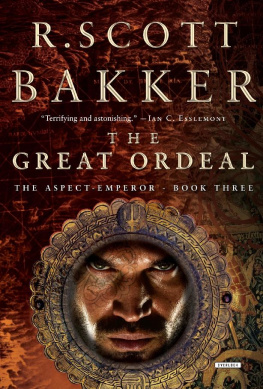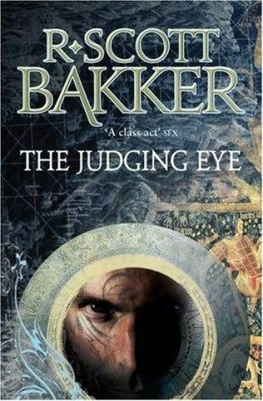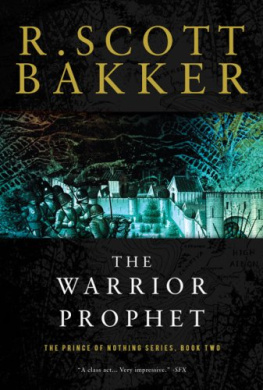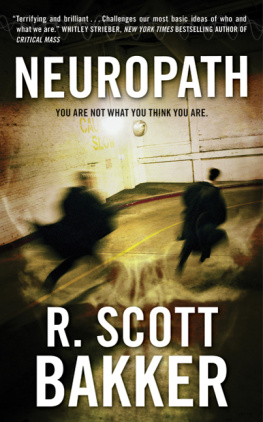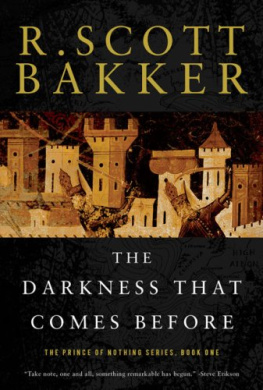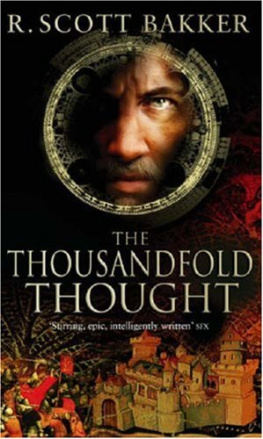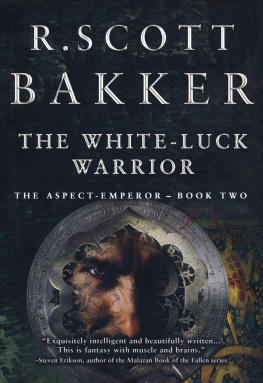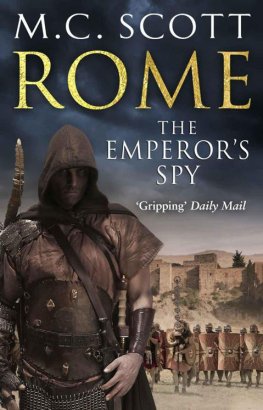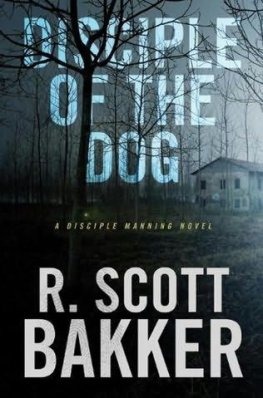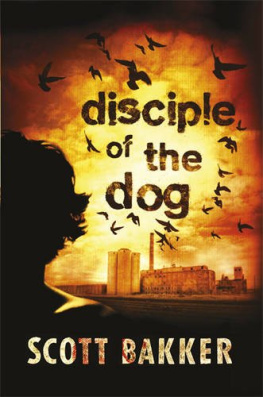R. SCOTT
BAKKER
THE GREAT ORDEAL
T HE A SPECT -E MPEROR , B OOK T HREE
With over 175,000 copies in print, the high fantasy novels of R. Scott Bakker, one of the godfathers of Grimdark, have dazzled fans around the world. With The Great Ordeal , Bakker presents the longanticipated third volume of The Aspect-Emperor, a series that stands with the finest in the genre for its grand scope, rich detail, and thrilling story.
As Fanim war-drums beat just outside the city, the Empress Anasrimbor Esmenet searches frantically throughout the palace for her missing son Kelmomas. Meanwhile untold leagues away, Esmenets husbands Great Ordeal continues its epic crusade ever northward, where their first encounter of the Consult and their alien tekne has catastrophic effects. And deep in Ishul, the wizard Achamian discovers secrets that begin to unravel the mystery of the Dunyain.
The Aspect-Emperor series follows Bakkers Prince of Nothing saga, returning to the same world twenty years later. The Great Ordeal follows The Judging Eye and The White-Luck Warrior , and delivers the first half of the conclusion to this epic story.
THE PRINCE OF NOTHING SERIES
The Darkness That Comes Before, Book One
The Warrior-Prophet, Book Two
The Thousandfold Thought, Book Three
THE ASPECT-EMPEROR SERIES
The Judging Eye, Book One
The White-Luck Warrior, Book Two
W RITING AS S COTT B AKKER
Neuropath
Disciple of the Dog
This edition first published in hardcover in the United States in 2016 by
The Overlook Press, Peter Mayer Publishers, Inc.
141 Wooster Street
New York, NY 10012
www.overlookpress.com
For bulk and special sales, please contact or write to us at the above address.
Copyright 2016 by R. Scott Bakker
All rights reserved. No part of this publication may be reproduced or transmitted in any form or by any means, electronic or mechanical, including photocopy, recording, or any information storage and retrieval system now known or to be invented, without permission in writing from the publisher, except by a reviewer who wishes to quote brief passages in connection with a review written for inclusion in a magazine, newspaper, or broadcast.
ISBN 978-1-4683-1351-2
To Frank and Ken

Contents
THE PRINCE OF NOTHING
Wars, as a rule, fall within the compass of history. They mark the pitch of competing powers, the end of some and the ascendancy of others, the ebb and flow of dominance across the ages. But there is a war that Men have waged for so long they have forgotten the languages they first used to describe it. A war that makes mere skirmishes out of the destruction of tribes and nations.
There is no name for this war; Men cannot reference what transcends the short interval of their comprehension. It began when they were little more than savages roaming the wilds, in an age before script or bronze. An Ark, vast and golden, toppled from the void, scorching the horizon, throwing up a ring of mountains with the violence of its descent. And from it crawled the dread and monstrous Inchoroi, a race who had come to seal the world against the Heavens, and so save the obscenities they called their souls.
The Nonmen held sway in those ancient days, a long-lived people that surpassed Men not only in beauty and intellect, but in wrath and jealousy as well. With their Ishroi heroes and Quya mages, they fought titanic battles and stood vigilant during epochal truces. They endured the Inchoroi weapons of light. They survived the treachery of the Aporetics, who provided the Inchoroi with thousands of sorcery-killing Chorae. They overcame the horrors their enemy crafted: the Sranc, the Bashrag, and most fearsome of all, the Wracu. But their avarice at last betrayed them. After centuries of intermittent war, they made peace with the invaders in return for the gift of ageless immortalitya gift that was in fact a fell weapon, the Plague of Wombs.
In the end, the Nonmen hunted the Inchoroi to the brink of annihilation. Exhausted, culled of their strength, they retired to their underworld mansions to mourn the loss of their wives and daughters, and the inevitable extinction of their glorious race. Their surviving mages sealed the Ark, which they had come to call Min-Uroikas, and hid it from the world with devious glamours. And from the eastern mountains, the first tribes of Men began claiming the lands they had abandonedMen who had never known the yoke of slavery. Of the surviving Ishroi Kings, some fought, only to be dragged under by the tide of numbers, while others simply left their great gates unguarded, bared their necks to the licentious fury of a lesser race.
And so human history was born, and perhaps the Nameless War would have ended with the fading of its principals. But the golden Ark still existed, and the lust for knowledge has ever been a cancer in the hearts of Men.
Centuries passed, and the mantle of human civilization crept along the great river basins of Erwa and outward, bringing bronze where there had been flint, cloth where there had been skins, and writing where there had been recital. Great cities rose to teeming life. The wilds gave way to cultivated horizons.
Nowhere were Men more bold in their works, or more overweening in their pride, than in the North, where commerce with the Nonmen had allowed them to outstrip their more swarthy cousins to the South. In the legendary city of Sauglish, those who could discern the joints of existence founded the first sorcerous Schools. As their learning and power waxed, a reckless few turned to the rumours they had heard whispered by their Nonman teachersrumours of the great golden Ark. The wise were quick to see the peril, and the Schoolmen of Mangaecca, who coveted secrets above all else, were censured, and finally outlawed.
But it was too late. Min-Uroikas was foundoccupied.
The fools discovered and awakened the last two surviving Inchoroi, Aurax and Aurang, who had concealed themselves in the labyrinthine recesses of the Ark. And at their hoary knees the outlaw Schoolmen learned that damnation, the burden that all sorcerers bore, need not be inevitable. They learned that the world could be shut against the judgment of Heaven. So they forged a common purpose with the twin abominations, a Consult , and bent their cunning to the aborted designs of the Inchoroi.
The Mangaecca relearned the principles of the materialthe Tekne. They mastered the manipulations of the flesh. And after generations of study and searching, after filling the pits of Min-Uroikas with innumerable corpses, they realized the most catastrophic of the Inchorois untold depravities: Mog-Pharau, the No-God.
They made themselves slaves to better destroy the world.
And so the Nameless War raged anew. What has come to be called the First Apocalypse destroyed the great Norsirai nations of the North, laying ruin to the greatest glories of Men. But for Seswatha, the Grandmaster of the Gnostic School of Sohonc, the entire world would have been lost. At his urging, Anasrimbor Celmomas, the High King of the Norths mightiest nation, Kniri, called on his tributaries and allies to join him in a holy war against Min-Uroikas, which Men now called Golgotterath. But his Ordeal foundered, and the might of the Norsirai perished. Seswatha fled south to the Ketyai nations of the Three Seas, bearing the greatest of the legendary Inchoroi weapons, the Heron Spear. With Anaxophus, the High King of Kyraneas, he met the No-God on the Plains of Mengedda, and by dint of valor and providence, overcame the dread Whirlwind.
The No-God was dead, but his slaves and his stronghold remained. Golgotterath had not fallen, and the Consult, blasted by ages of unnatural life, continued to plot their salvation.
Next page
